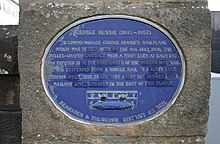| This article needs additional citations for verification. Please help improve this article by adding citations to reliable sources. Unsourced material may be challenged and removed. Find sources: "Bennie Railplane" – news · newspapers · books · scholar · JSTOR (August 2015) (Learn how and when to remove this message) |


The Bennie Railplane was a form of rail transport invented by George Bennie (1891–1957), which moved along an overhead rail by way of propellers.
Prototype
Bennie, born at Auldhouse, near Glasgow, Scotland began work on the development of his railplane in 1921. In 1929-1930 he built a prototype on a trial stretch of track over a 130-yard (119-metre) line at Milngavie, off the Glasgow and Milngavie Junction Railway, with one railplane car to demonstrate the system to potential clients. The car ran along an overhead monorail, stabilised by guide rails below. It moved by propellers powered by on-board motors. It was intended to run above conventional railways, separating faster passenger traffic from slower freight traffic. Bennie believed his railplane cars had the capability of travelling up to 120 mph (193 km/h) and would offer a "fast passenger and mails and perishable goods service". Slow and heavy goods freight and local passenger services would continue on the traditional rail service below. Each car could carry a maximum of 48 people; the prototype had seating for fewer.
In spite of interest from around the world, Bennie could not obtain the financial backing he required to develop his revolutionary transport system. The proposed line from Edinburgh to Glasgow was not built, nor was the one between Southport and Blackpool. By 1937, Bennie was bankrupt. He had financed most of the work himself.
The prototype railplane lay rusting in a field at Milngavie until it was sold for scrap in 1956. Bennie died the following year. The original shed where the carriage was built in Main Street, Milngavie is now occupied by a timber merchant, and has a blue commemorative plaque on the outside wall.
See also
Further reading
- Thwaite, Malcolm (2005). "The George Bennie Railplane and Hugh Fraser Airrail Systems of Transport". Transactions of the Newcomen Society. 75 (1): 37–84. doi:10.1179/tns.2005.003. ISSN 0372-0187. S2CID 111217453.
- Black, William B. The Bennie Railplane. East Dunbartonshire Council. (ISBN 0904966577)
References
External links
- George Bennie Railtrack, Baldernock Parish
- The Bennie Railplane, Gear Wheels Online Motoring Magazine
- George Bennie Railplane System of Transport (1930) (archive film from the National Library of Scotland: Scottish Screen Archive)
- Railplane newsreel footage at British Pathe
- Film of test run (BBC Scotland)
- The Newcomen Rolt Prize
- Further info on Mike's Railway History
- "Bennie Railplane". Secret Scotland wiki. Retrieved 8 July 2013.
- Footage
55°55′55.2″N 4°18′57.7″W / 55.932000°N 4.316028°W / 55.932000; -4.316028
Categories: